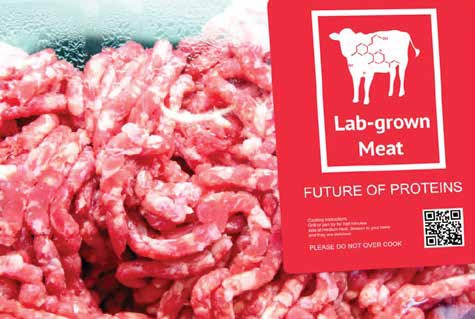Posted: October 4, 2019
What is it? Many questions remain on cell-cultured meat production.
Food spurs a seemingly never-ending debate among individuals. Indeed, the battle over how we produce food has a long history of public discourse and scrutiny. This is particularly true for new food production methods, and rightfully so. We should be cautious about where our food comes from and how it is produced. But in order to make educated decisions and put safe food practices into place, we must first agree on how to classify new food products, essentially answering the question: What is it? This question has gained unprecedented relevance in the past year as debates have ensued regarding the definition of cell-culture-based meat--"meat" produced by in vitro cultivation of animal cells, rather than from animal harvest.
Meat that is produced from livestock (beef, lamb, pork, poultry) is currently handled inside a well-defined system that emphasizes the use of specific food safety practices by the farmer and the butcher. The product is then verified by an inspector as safe for consumption. This leaves buyers to purchase a product at their discretion that has been properly investigated as safe to eat. All meat in the United States that is available on grocery store shelves must go through this process.
Cell-culture-based meat production, however, is not yet regulated under the same system. Traditionally, cell-culture-based food and pharmaceutical production have been regulated solely by the Food and Drug Administration (FDA), which oversees development of drug- and plant-based food products. In contrast, livestock and meat production are regulated by the United States Department of Agriculture's Food Safety Inspection Service (USDA-FSIS).
Initially, proponents of cell-culture-based meat proposed that cell-culture-based meat production should be regulated by the FDA due to the raw product being primarily created in a cell culture dish--a sterile environment. However, livestock production also generates meat in a sterile environment. Both products share properties, regardless of production method, that subject the raw material to the same food safety challenges once they are removed from the sterility of their preharvest environment. Under these conditions, only the USDA-FSIS has a system in place to regulate and accommodate this shared issue in food safety across raw meat and animal products.
In November 2018 it was decided that the FDA and USDA-FSIS would share responsibility for regulation of this novel food production method. A memorandum released by the FDA and USDA-FSIS in March outlines how those responsibilities would be divided across agencies, with FDA regulating the cell culture technique, and the USDA-FSIS overseeing the postculture processing and food safety to point of purchase. So, even though cell-culture-based meat products are not yet available on grocery shelves, this collaboration recognizes that this is an animal-derived product that requires oversight and regulation like more traditional animal-derived products. This recognition is the first step in investigating this novel process of food production and where it might fit into our diets.
Fine-tuning the definition of "meat" and products derived from cell-culture-based food production will influence how current livestock producers and the public respond to this new product. Yet, little research is publicly available on cell-culture-based meat production and many questions remain, especially regarding the claim that it is cleaner, safer, or more environmentally efficient than traditional livestock production. Additionally, the debate around even defining this product as "meat" continues. To date, 13 states have written legislation that classifies "meat" as strictly a product harvested from livestock.
As we navigate this new food frontier, joint oversight by the FDA and the USDA-FSIS regarding cell-culture-based meat paves the way for research and continued discussion on naming and regulation. This is truly where the "meat of the conversation" on food production begins.
Elizabeth Hines is an assistant professor of animal science and an extension specialist.
Features
Fostering Forests
Across the United States, forests face unprecedented threats, and scientists in Penn State's College of Agricultural Sciences are conducting novel and complex research to conserve them.
Buzzing With Purpose
Community scientists work to protect Pennsylvania's wild bees
Conservation Reimagined
Exploring new approaches to cope with a changing climate



